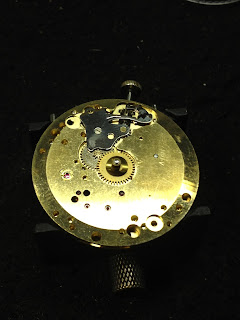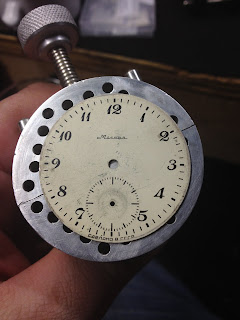Here an exploded view of a SAA
Reading up on the firearm, mine was produced 1902 and has seen the armory at least three times. The grips are the original smooth walnut grip and the inspector stamp of RAC faded, but can be made out
RAC were the initials of the civilian government employed sub-inspector at Colt, whose name is Rinaldo A. Carr between 1890 to 1903. Speaking of initials, two others can be found on one side of the frame
L.E.B. were the initials that belonged to a one Leroy E. Briggs who was an Army Captain that inspected revolvers rebuilt and refurbished at Remington's Bridgeport plant between 1898 to 1917 and the other set of letters, J.T.T belonged to none other than US Army Captain John Taliaferro Thompson who will go on to invent the Thompson Machine Gun, A.K.A Tommy Gun in 1919. The 'K' on the cylinder release is a Colt manufacturing stamp.
The stamp on the frame on the butt of the gun shows the model and serial
The side of the frame and barrel stamps showing the caliber and the 'other' model name
Next set of photos are the inspector stamps and serials in various locations, you can see a change in numbers which indicates that a part was upgraded at the armory and it is coded for the new replacement part.Another roll mark is the patent date atop the barrel near the frame;
It is time to remove the grips in order to remove the side plate and inspect the action of the firearm. When I removed the grips, I came across something that I have only read about. It was a known practice that soldiers would sometimes carve something no the inside of the grip, typically a name. Here we see inscriptions on both sides, one with what appears to be 'S R Graham C.F.K. 36' and the other grip, 'Kingfisher Oklahoma'. I can only surmise that C.F.K is Cambrai Fritsch Kaserne, where work began in 1936 and completed in 1938. There was a north and south kasemes (Kaseme is a borrowed word from German which translates to 'barracks') and the 33rd Infantry and Artillery occupied the Freiherr von Fritsch Kaserne in the north and the 3rd Battalion in Cambrai Kaserne in the south. This would put the firearm, likely the last time it was service in Darmstadt, Germany (well, a city within a federal state of Germany), what a cool find.
The side plate opens to reveal the action to find it packed with grease, likely at the final armory trip for long term storage. The inside of the plate also shows a serial number matching to the original;
I get to cleaning out the grease packing and the action immediately improves so I continued cleaning until it is back to good operating order; and after all of this time the action is till like ball bearings on glass. I use spent .38 spl cases as snap caps to test the action, hammer energy and what not and everything seems to be a-ok. Time for a range trip!



















































